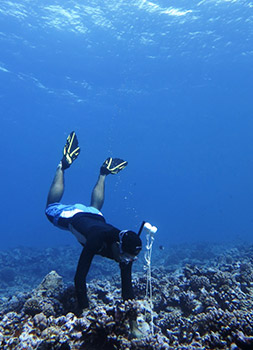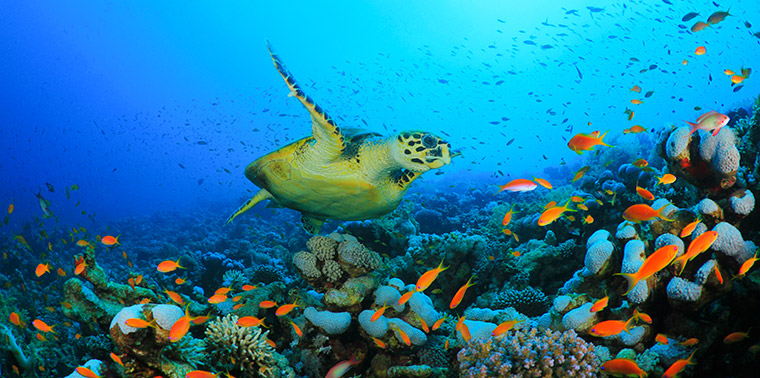February 15, 2017 — In 2013, Katherine Indeck listened to recordings of sounds made in a channel between the Gulf of Mexico and Tampa Bay, Florida. Some of the audio files had been collected in 2005 during an unusually severe red tide, a bloom of toxic algae that killed fish, dolphins and sea turtles. Other recordings were made after the ecosystem began to recover.
During the recovery years, Indeck could hear sounds from animals such as snapping shrimp, which she likens to bacon grease popping in a pan. But during the red tide, the recordings were eerily quiet. In her mind, she could “see the tumbleweeds going by,” says Indeck, now a marine ecologist at the University of Queensland in Australia. “The ambient noise in those sound files was near silent.”
A recording of a channel between the Gulf of Mexico and Tampa Bay, Florida during a severe red tide in August 2005 is very quiet. Credit: Indeck et al 2015.
A recording of the same channel in August 2006, after the severe red tide was over, is much louder. Credit: Indeck et al 2015
A report with these observations, published in 2015, shows how a soundscape — the noises made by animals, weather, waves and human sources — can reflect the health of a coastal ecosystem. Some researchers hope that acoustic monitoring could help reveal environmental damage more easily and cheaply than visual surveys done by divers. Fish produce sounds ranging from croaks to booms to rapid pulses, and changes in their sound-making patterns could signify shifts in numbers, diversity or behavior. The data could help scientists understand the effects of human activities on marine habitat and, if needed, back up arguments to politicians and managers that the source of the damage should be stopped.
Marine biologist and independent science communicator Tullio Rossi explains how snapping shrimp make their distinctive sounds. Credit: Dr. Tullio Rossi.
While the method probably won’t replace visual surveys entirely, a sudden hush could tip off scientists to investigate. “If a major event happens and you hear them go quiet, then that can be a catalyst to go out and try and get more data,” Indeck says.
Coral Choruses
People often assume that oceans are quiet, aside from the noises made by whales and dolphins. But small animals chatter too. For instance, damselfish open and close their jaws with a brrrp brrrp, triggerfish brush their pectoral fins against their bodies to produce a keek-keek-keek and drum fish contract muscles around an organ called the swim bladder to make a drumming sound. “Some fishes are really loud,” says Frédéric Bertucci, a bioacoustician at the Insular Research Center and Environment Observatory in Perpignan, France.

Researchers have studied ocean soundscapes at sites in Moorea, French Polynesia, including this marine protected area. Photo courtesy of L. Thiault.
In a study published last year, Bertucci’s team investigated whether certain acoustic measurements were linked to healthier coral reefs. The researchers recorded four marine protected areas and four unprotected areas along the coast of the island Moorea, French Polynesia. Divers also counted fish, identified species and measured coral cover.
A boomerang triggerfish recorded in Moorea brushes its pectoral fins against its body to produce its distinct sound. Credit: CRIOBE/Univ. Liège.
A white-spotted damselfish recorded in Moorea makes its sound by opening and closing its jaws. Credit: CRIOBE/Univ. Liège.
Sites with more coral cover were louder, the team found. And areas with richer biodiversity tended to produce more complex daytime choruses with a wider variety of sounds. “You can, of course, hear the difference,” Bertucci says. “Reefs in good condition are really noisy.”

Researcher David Lecchini positions a recorder in Moorea. Photo courtesy of C. Berthe.
Other studies have linked acoustic changes to threats such as ocean acidification, nutrient pollution and fishing. One team compared the soundscapes of sites in Italy and New Zealand with varying levels of dissolved carbon dioxide, and thus different acidity. The researchers also monitored healthy kelp forests in Australia and nearby polluted areas taken over by carpets of algae. “It’s like going from a forest to weeds,” says co-author Tullio Rossi, a marine biologist who is now an independent science communicator based in Adelaide. In both cases, snapping shrimp made less noise at the degraded sites, the team reported last year. In a study published in January, French scientists performed a similar analysis on maerl beds, deposits of red algae that provide homes for animals such as sea urchins, starfish and clams. A maerl bed that had been fished was three times quieter than an unfished bed, the researchers found.
Drowned Out
The results hint that acoustic monitoring could help scientists track the health of coastal ecosystems. Today, divers usually scan these ecosystems, but this method is time-consuming and can disturb the animals. Plus, visual surveys can be done only for short stretches during the day in clear water. Instead, researchers could install underwater microphones to collect data for months, even in dark, murky environments. “You can do it every day, every night,” Bertucci says.
But this approach may not work for all sites. Erica Staaterman, an acoustic ecologist at the Smithsonian Environmental Research Center in Edgewater, Maryland, ran into hurdles when her team recorded reef, mangrove, sand and seagrass habitat in Panama last year. At many sites, members of one toadfish species croaked so loudly at night that the scientists could barely hear the other animals. “They basically drowned out the whole soundscape,” she says. Indeck encountered a similar problem while listening to her Florida recordings. Once the snapping shrimp recovered from the red tide, their incessant popping masked the sounds of bottlenose dolphins that she wanted to study.
When researchers tried to study marine soundscapes in Panama, they found that a particularly loud toadfish species drowned out many other animals. Credit: Erica Staaterman.
But researchers could try to select sites that aren’t dominated by the noise of a single species, Indeck says. After collecting baseline data to determine the normal soundscape, scientists could detect unusually quiet spells — and find out what’s behind the silence.
![]()
Ensia shares solutions-focused stories free of charge through our online magazine and partner media. That means audiences around the world have ready access to stories that can — and do — help them shape a better future. If you value our work, please show your support today.
Yes, I'll support Ensia!
